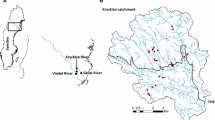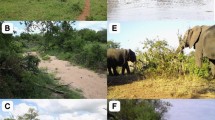Abstract
The lack of a clear understanding of the factors governing the often-great variation of species numbers over entire landscapes confounds attempts to manage biodiversity. We hypothesized that in a topographically variable boreal forest landscape the availability of shallow groundwater is a major determinant of plant species numbers. We then developed a topographically derived hydrologic index based on multidirectional flow algorithms to account for the variation in availability of such groundwater in the landscape. We found a positive correlation between species numbers of vascular plants in plots ranging from 0.01 to 200 m2 and the hydrologic index. Generally, the landscape was relatively dry and species-poor, but interspersed patches with shallow groundwater had high species numbers and high proportions of regionally uncommon plant species. The index explained 30% of the variation in vascular plant number and correlated quite well (rs = 0.50) with groundwater level, but not as well with a community H+ concentration value (instead of community pH, rs = −0.31), based on species composition. In addition, we found a very strong correlation between species number and the community H+ concentration value (rs −0.84). The hydrologic index is a useful tool for the identification of spatial of species number patterns across entire landscapes. This is an important step in identifying the areas most in need of protection or restoration, designing survey techniques, and understanding the fundamental processes that control the spatial distribution of species.




Similar content being viewed by others
References
TW Beers PE Dress LC Wensel (1966) ArticleTitleAspect transformation in site productivity research J For 64 691–2
KD Bennett (1997) Evolution and ecology: the pace of life Cambridge University Press Cambridge (UK)
KJ Beven MJ Kirkby (1979) ArticleTitleA physically based, variable contributing area model of basin hydrology Hydrol Sci J 24 43–69
K Bishop E Dambrine (1995) ArticleTitleLocalization of tree water uptake in Scots pipe and Norway spruce with hydrological tracers Canadian J For Res 25 286–97
RA Brualdi JG Sanderson (1999) ArticleTitleNested species subsets, gaps, and discrepancy Oecologia 119 256–64 Occurrence Handle10.1007/s004420050784
AK Cajander (1926) ArticleTitleThe theory of forest types Acta For Fenn 29 1–108
SJ Chipman EA Johnson (2002) ArticleTitleUnderstory vascular plant species diversity in the mixedwood boreal forest of western Canada Ecol Appl 12 588–601
MJ Crawley JE Harral (2001) ArticleTitleScale dependence in plant biodiversity Science 291 864–8 Occurrence Handle10.1126/science.291.5505.864 Occurrence Handle11157164
B Dorner K Lertzman J Fall (2002) ArticleTitleLandscape pattern in topographically complex landscapes: issues and techniques for analysis Landscape Ecol 17 729–43 Occurrence Handle10.1023/A:1022944019665
M Dynesius (2001) Spatial and evolutionary aspects of species diversity, species traits, and human impact with examples from boreal riparian and forest plant communities [dissertation] Umeå University UmeåSweden
F Ebeling (1978) ArticleTitleNordsvenska skogstyper Sver Skogsvårds Tidsk 76 341–81
R Giesler M Högberg P Högberg (1998) ArticleTitleSoil chemistry and plants in Fennoscandian boreal forest as exemplified by a local gradient Ecology 79 119–37
PJ Grubb (1987) Global trends in species-richness in terrestrial vegetation: a view from the northern hemisphere JHR Gee PS Giller (Eds) Organization of communities past and present Blackweil Scientific Oxford (UK) 98–118
RK Heikkinen (1991) ArticleTitleMultivariate analysis of esker vegetation in southern Häme, S Finland Ann Bot Fenn 28 201–24
G Hewitt (2000) ArticleTitleThe genetic legacy of the Quaternary ice ages Nature 405 907–13 Occurrence Handle10.1038/35016000 Occurrence Handle10879524
KN Hjerdt JJ McDonell J Seibert A Rodhe (2004) ArticleTitleA new topographic index to quantify downslope controls on local drainage water Resour Res 40 W05602 Occurrence Handle10.1029/2004WR003130
TF Hutchinson REJ Boerner LR Iverson S Sutherland KS Sutherland (1999) ArticleTitleLandscape patterns of understory composition and richness across a moisture and nitrogen mineralization gradient in Ohio (U.S.A) Quercus forests Plant Ecol 144 177–89 Occurrence Handle10.1023/A:1009804020976
LR Iverson ME Dale CT Scott A Prasad (1997) ArticleTitleA GIS-derived integrated moisture index to predict forest composition and productivity of Ohio forests (U.S.A.) Landscape Ecol 12 331–48 Occurrence Handle10.1023/A:1007989813501
BG Jonsson (2001) ArticleTitleA null model for randomization tests of nestedness in species assemblages Oecologia 127 309–13 Occurrence Handle10.1007/s004420000601
R Lamb KJ Beven S Myrabø (1997) ArticleTitleDischarge and water table predictions using a generalized TOPMODEL formulation Hydrol Proc 11 1145–67 Occurrence Handle10.1002/(SICI)1099-1085(199707)11:9<1145::AID-HYP550>3.0.CO;2-C
TOBN Krok S Almquist (2001) Svensk flora: fanerogamer och ormbunksväxter Liber Utbildning Stockholm
ID Moore RB Grayson AR Ladson (1991) ArticleTitleDigital terrain modelling: a review of hydrological, geomorphological, and biological applications Hydrol Process 5 5–30
RD Moore JC Thompson (1996) ArticleTitleAre water table variations in a shallow forest soil consistent with the TOPMODEL concept? Water Resour Res 32 663–9 Occurrence Handle10.1029/95WR03487
WF Nichols KT Killingbeck PV August (1998) ArticleTitleThe influence of geomorphological heterogeneity on biodiversity: II A landscape perspective. Conserv Biol 12 371–9
RH Økland O Eilertsen (1994) ArticleTitleCanonical correspondence analysis with variation partitioning: some comments and an application J Ve Sci 5 117–26
M O’Loughlin (1986) ArticleTitlePrediction of surface saturation zones in natural catchments by topographic analysis Water Resour Res 22 794–804
B Ostendorf JF Reynolds (1998) ArticleTitleA model of arctic tundra vegetation derived from topographic gradients Landscape Ecol 13 187–201 Occurrence Handle10.1023/A:1007986410048
M Pärtel (2002) ArticleTitleLocal plant diversity patterns and evolutionary history at the regional scale Ecology 83 2361–6
B Patterson W Atmar (1986) ArticleTitleNested subsets and the structure of insular mammalian faunas and archipelagos Biol J Linn Soc 28 65–82
PF Quinn K Beven P Chevallier O Planchon (1991) ArticleTitleThe prediction of hillslope flow paths for distributed hydrological modelling using digital terrain models Hydrol Process 5 59–79
PF Quinn KJ Beven R Lamb (1995) ArticleTitleThe ln(a/tanβ) index: how to calculate it and how to use it within the topmodel framework Hydrol Process 9 161–82
A Rodhe J Seibert (1999) ArticleTitleWetland occurrence in relation to topography: a test of topographic indices as moisture indicators Agric For Meteorol 98–99 325–40 Occurrence Handle10.1016/S0168-1923(99)00104-5
J Seibert K Bishop L Nyberg (1997) ArticleTitleA test of TOPMODEL’s ability to predict spatially distributed groundwater levels Hydrol Proc 11 1131–44 Occurrence Handle10.1002/(SICI)1099-1085(199707)11:9<1131::AID-HYP549>3.3.CO;2-R
F Skov JC Svenning (2003) ArticleTitlePredicting plant species richness in a managed forest For Ecol Manag 180 583–93
JA Stanford (1997) Toward a robust water policy for the western USA: a synthesis of the science WL Minckley (Eds) Aquatic ecosystem symposium: a report to the Western Water Policy Review Advisory Commission Arizona State University Tempe (AZ) 79–84
DG Tarboton (1997) ArticleTitleA new method for the determination of flow directions and upslope areas in grid digital elevation models Water Resour Res 33 309–19 Occurrence Handle10.1029/96WR03137
JC Trexler J Travis (1993) ArticleTitleNontraditional regression analyses Ecology 74 1629–37
AW Western RB Grayson G Blösehl GR Willgoose TA McMahon (1999) ArticleTitleObserved spatial organization of soil moisture and its relation to terrain indices Water Resour Res 35 797–810 Occurrence Handle10.1029/1998WR900065
RJ Whittaker KJ Willis RJ Field (2001) ArticleTitleScale and species richness: towards a general, hierarchical theory of species diversity J Biogeogr 28 453–70 Occurrence Handle10.1046/j.1365-2699.2001.00563.x
RN Williams PA Bisson DL Bottom LD Calvin CC Coutant MW Erho SuffixJr CA Frissell (1999) ArticleTitleScientific issues in the restoration of salmonid fishes in the Columbia River Fish Manag 24 10–9
KJ Willis RJ Whittaker (2000) ArticleTitleThe refugial debate Science 287 1406–7 Occurrence Handle10.1126/science.287.5457.1406 Occurrence Handle10722388
DM Wolock GJ McCabe (1995) ArticleTitleComparison of single and multiple flow direction algorithms for computing topographic parameters in TOPMODEL Water Resour Res 31 1315– 24 Occurrence Handle10.1029/95WR00471
EF Wood M Sivapalan K Beven L Band (1988) ArticleTitleEffects of spatial variability and scale with implications to hydrologic modeling J Hydrol 102 29–47 Occurrence Handle10.1016/0022-1694(88)90090-X
JA Yeakley WT Swank LW Swift GM Hornberger HH Shugart (1998) ArticleTitleSoil moisture gradients and controls on a southern Appalachian hillslope from drought through recharge Hydrol Earth System Sci 2 41–9
M Zobel (1997) ArticleTitleThe relative role of species pools in determining plant species richness: an alternative explanation of species coexistence? TREE or Trends Ecol Evol 12 266–9 Occurrence Handle10.1016/S0169-5347(97)01096-3
Acknowledgments
The Lamm Foundation, the Foundation for Strategic Environmental Research (MISTRA), the Swedish Research Council for Environment, Agricultural Sciences and Spatial Planning (to C.N.), and the Swedish Research Council (to J.S.) funded the project. We thank Kenneth Holmström, Metria, for the interpretation of aerial photographs, and Johan Temnerud, Johanna Lindeberg, Åsa Laurell, Gunilla Nordenmark, Gunilla Nilsson, Per-Erik Wikberg, Göran Brorsson, Johanna Englund, Magnus Larsson, Elisabet Carlborg, Pia Hansson, Magnus Svedmark, and Per Herngren for fieldwork assistance. Kevin Bishop, Niclas Hjerdt, Hans Ivarsson, Roland Jansson, Edward A. Johnson, Bengt-Gunnar Jonsson, and two journal reviewers provided useful comments on the manuscript.
Author information
Authors and Affiliations
Corresponding author
Rights and permissions
About this article
Cite this article
Zinko, U., Seibert, J., Dynesius, M. et al. Plant Species Numbers Predicted by a Topography-based Groundwater Flow Index. Ecosystems 8, 430–441 (2005). https://doi.org/10.1007/PL00021513
Received:
Accepted:
Published:
Issue Date:
DOI: https://doi.org/10.1007/PL00021513




